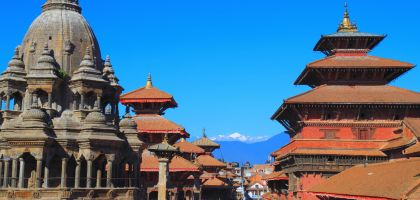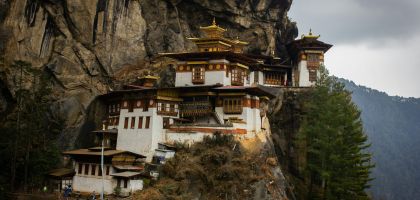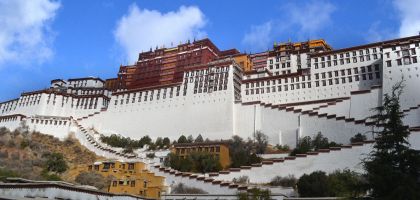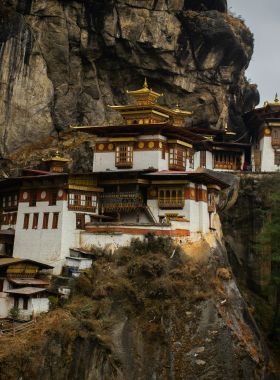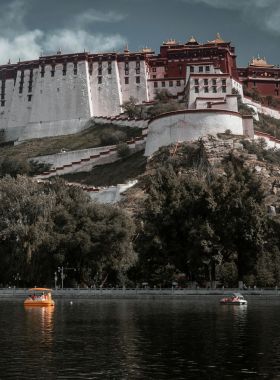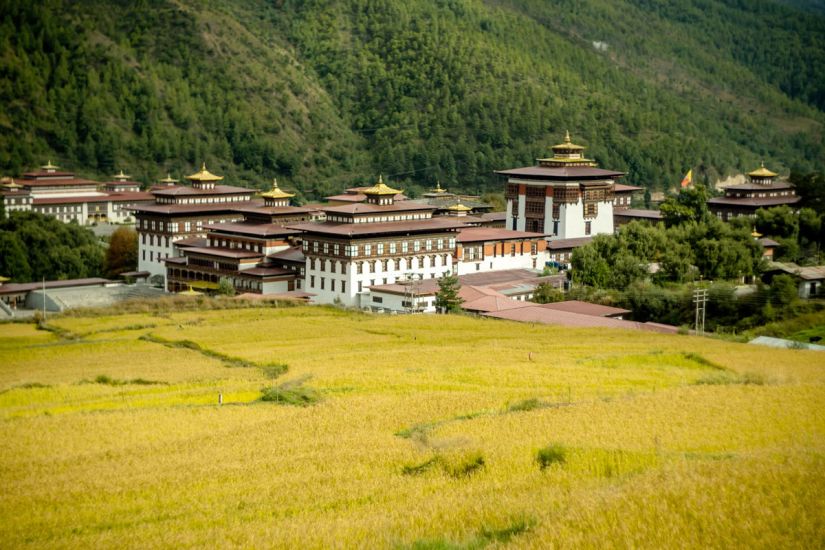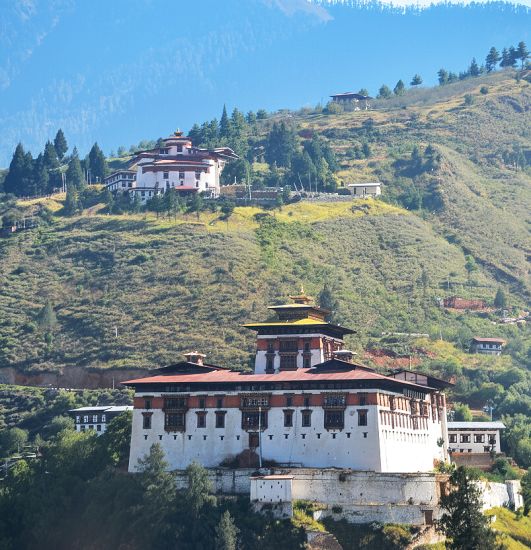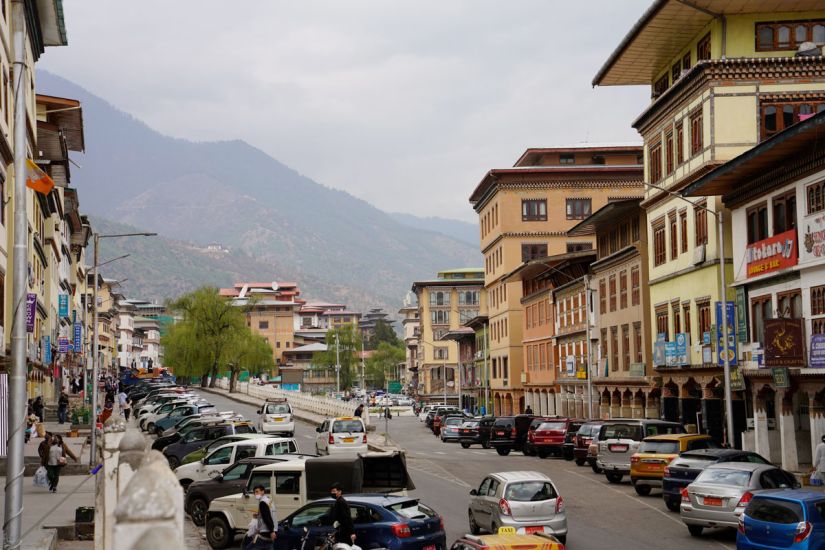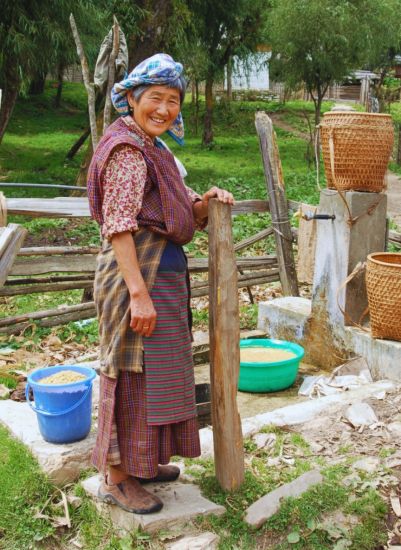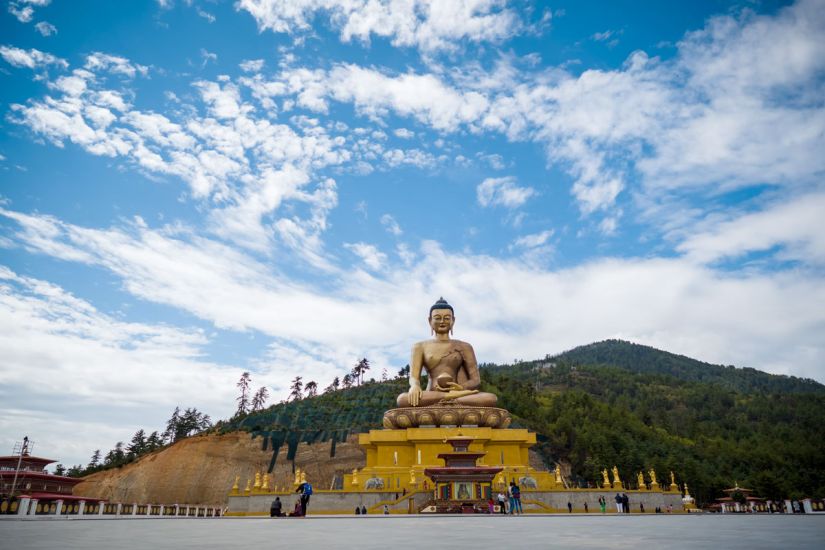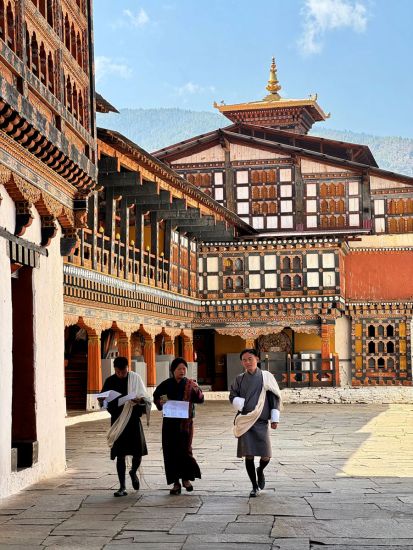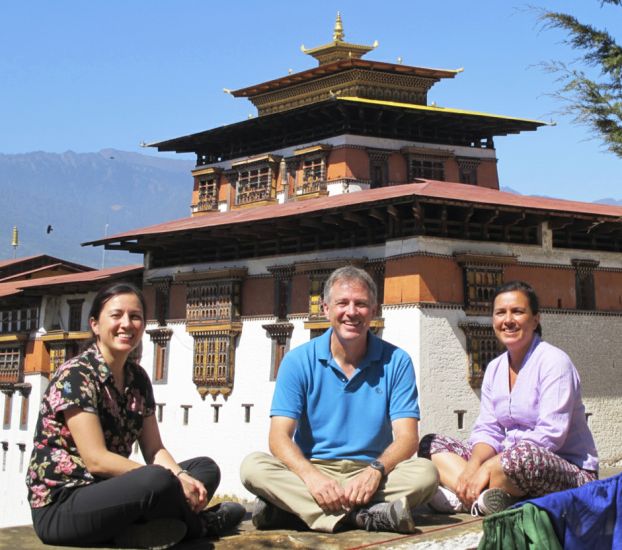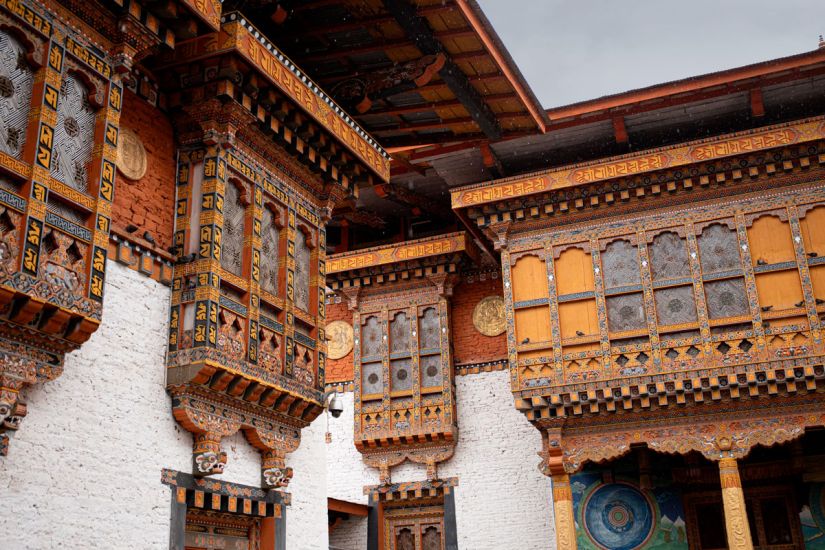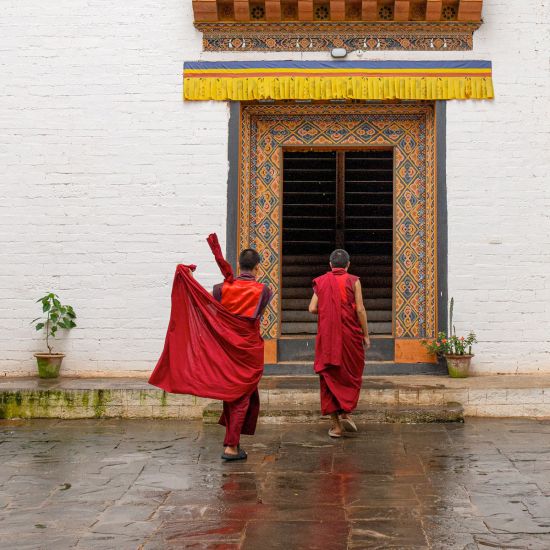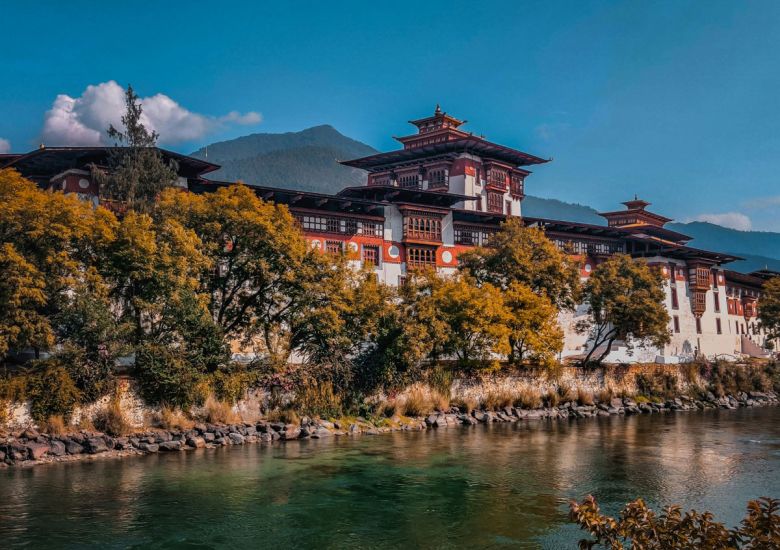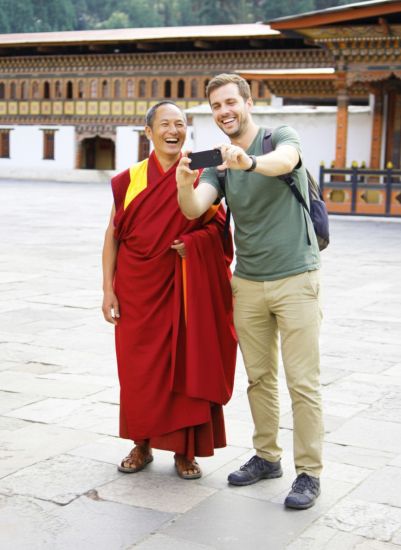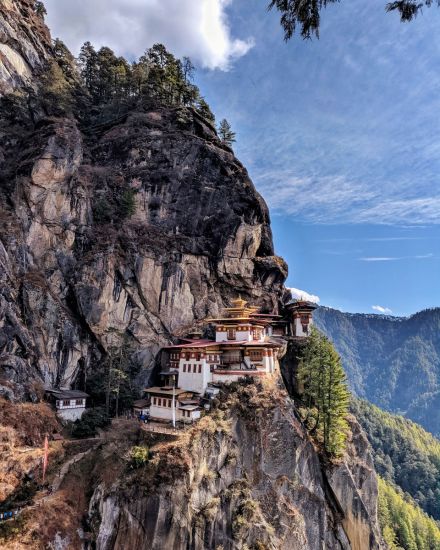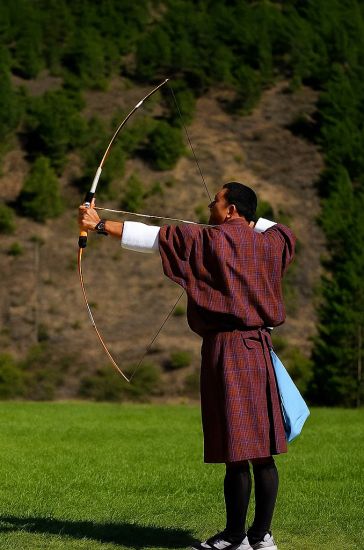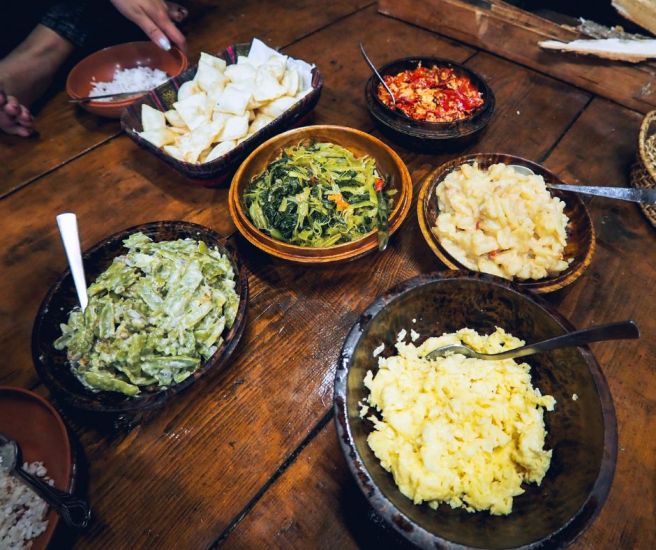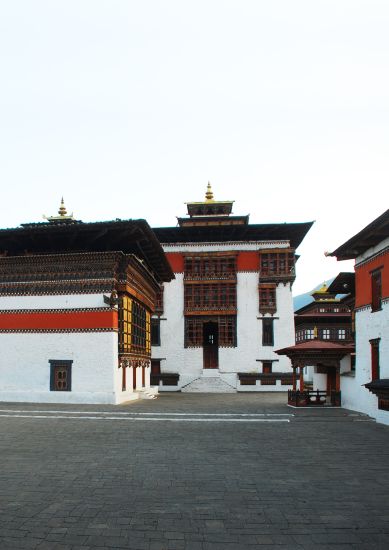Bhutan Cultural Tour
7 Days / Bhutan
Activity
Difficulty Level
Destinations
Trip Start / End
Max Altitude
Accommodation
Travel Style
Best time to travel
Personalized Travel Advice

Dev Raj Nepal
+977 9851096523
Personalized Travel Advice

Dev Raj Nepal
+977 9851096523
Detailed Itinerary
01
DAY
01
Touch down at Paro International Airport. Your Bhutan cultural tour begins with a scenic 1.5-hour drive to Thimphu, the tranquil capital, winding through emerald valleys and misty mountains.
Stop at Tachogang Lhakhang (Tamchog Lhakhang), a 15th-century monastery founded by Thangtong Gyalpo, revered in Bhutan for both spiritual teachings and early bridge engineering. Visitors cross the traditional iron chain bridge and explore the temple’s murals while learning about Bhutanese Buddhist traditions along the Paro Chhu River.
Arriving in Thimphu, check into your hotel and immerse yourself in a welcome briefing from your tour guide that give additional information on Bhutan’s culture and traditions and also about Bhutanese customs.
In the late afternoon, travelers will experience a Buddhist cleansing ceremony. This is a ritual led by monks to purify the mind, body, and surroundings. There will be chanting of mantras, the rhythmic ringing of bells, and the sprinkling of holy water. These rites have been designed to clear negative energies and invite auspicious blessings. This immersive ritual will give all participants a rare glimpse into Bhutan’s spiritual customs.
This evening marks the gentle beginning of this Bhutan cultural tour, a voyage where every step connects you with the soul of the Thunder Dragon Kingdom.
Arrival Paro & Drive to Thimphu
Touch down at Paro International Airport. Your Bhutan cultural tour begins with a scenic 1.5-hour drive to Thimphu, the tranquil capital, winding through emerald valleys and misty mountains.
Stop at Tachogang Lhakhang (Tamchog Lhakhang), a 15th-century monastery founded by Thangtong Gyalpo, revered in Bhutan for both spiritual teachings and early bridge engineering. Visitors cross the traditional iron chain bridge and explore the temple’s murals while learning about Bhutanese Buddhist traditions along the Paro Chhu River.
Arriving in Thimphu, check into your hotel and immerse yourself in a welcome briefing from your tour guide that give additional information on Bhutan’s culture and traditions and also about Bhutanese customs.
In the late afternoon, travelers will experience a Buddhist cleansing ceremony. This is a ritual led by monks to purify the mind, body, and surroundings. There will be chanting of mantras, the rhythmic ringing of bells, and the sprinkling of holy water. These rites have been designed to clear negative energies and invite auspicious blessings. This immersive ritual will give all participants a rare glimpse into Bhutan’s spiritual customs.
This evening marks the gentle beginning of this Bhutan cultural tour, a voyage where every step connects you with the soul of the Thunder Dragon Kingdom.
02
DAY
02
Bhutan’s culture is a combination of religion, spirituality, art, architecture, customs, traditions. You are going to explore these aspects in Bhutan this day. In the morning, we drive to Buddha Point (Buddha Dordenma), a monumental bronze Buddha statue overlooking Thimphu Valley. At 51 meters, it ranks among the largest Buddha statues in the world. The serene setting and panoramic views create a perfect moment for reflection and inspiration, offering a sense of calm and connection with the majesty of the Himalayas.
Next, visit Changangkha Lhakhang, a 12th-century hilltop temple dedicated to the protective deity of children. The interiors are adorned with sacred paintings and statues, while the surrounding terraces provide sweeping views of Thimphu city. This spiritual space offers insight into Bhutanese Buddhist practices and a quiet spot for contemplation and cultural immersion.
Continue to Zorig Chusum, the Institute of Traditional Arts, where students train in the 13 traditional Bhutanese arts, including painting, sculpture, weaving, and woodcarving. Witnessing their skill and dedication is an inspiring reminder of creativity, resilience, and the role of artisans in preserving Bhutan’s cultural heritage.
Next, explore the Crafts Bazaar, a vibrant market offering handmade textiles, jewelry, and handicrafts. This lively space provides a meaningful opportunity to support Bhutanese creativity and experience the country’s rich artistic traditions firsthand.
Pause at the National Memorial Chorten, built in memory of Bhutan’s third king. A focal point for daily prayer and circumambulation, it offers insight into local spiritual life and a quiet moment for personal reflection.
Conclude your day of cultural exploration at Tashichho Dzong, a magnificent fortress-monastery housing government offices and monastic quarters. This Dzong is also an administrative center and it is best to visit after 5pm as parking will be unavailable during the office hours. Your tour guide will tell you about its impressive architecture, golden roofs, and tranquil courtyards, especially magical at sunset. The Dzong exemplifies the seamless blend of spirituality, governance, and artistry that defines Bhutanese society.
Thimphu Exploration
Bhutan’s culture is a combination of religion, spirituality, art, architecture, customs, traditions. You are going to explore these aspects in Bhutan this day. In the morning, we drive to Buddha Point (Buddha Dordenma), a monumental bronze Buddha statue overlooking Thimphu Valley. At 51 meters, it ranks among the largest Buddha statues in the world. The serene setting and panoramic views create a perfect moment for reflection and inspiration, offering a sense of calm and connection with the majesty of the Himalayas.
Next, visit Changangkha Lhakhang, a 12th-century hilltop temple dedicated to the protective deity of children. The interiors are adorned with sacred paintings and statues, while the surrounding terraces provide sweeping views of Thimphu city. This spiritual space offers insight into Bhutanese Buddhist practices and a quiet spot for contemplation and cultural immersion.
Continue to Zorig Chusum, the Institute of Traditional Arts, where students train in the 13 traditional Bhutanese arts, including painting, sculpture, weaving, and woodcarving. Witnessing their skill and dedication is an inspiring reminder of creativity, resilience, and the role of artisans in preserving Bhutan’s cultural heritage.
Next, explore the Crafts Bazaar, a vibrant market offering handmade textiles, jewelry, and handicrafts. This lively space provides a meaningful opportunity to support Bhutanese creativity and experience the country’s rich artistic traditions firsthand.
Pause at the National Memorial Chorten, built in memory of Bhutan’s third king. A focal point for daily prayer and circumambulation, it offers insight into local spiritual life and a quiet moment for personal reflection.
Conclude your day of cultural exploration at Tashichho Dzong, a magnificent fortress-monastery housing government offices and monastic quarters. This Dzong is also an administrative center and it is best to visit after 5pm as parking will be unavailable during the office hours. Your tour guide will tell you about its impressive architecture, golden roofs, and tranquil courtyards, especially magical at sunset. The Dzong exemplifies the seamless blend of spirituality, governance, and artistry that defines Bhutanese society.
03
DAY
03
Continue your Bhutan cultural tour at the Folk Heritage Museum in the morning. This is a captivating space where traditional rural Bhutanese life comes alive. Explore restored traditional houses, complete with antique household items, farming tools, and traditional Bhutanese attire.
Next, visit the National Textile Museum, a treasure trove of Bhutan’s textile heritage. Admire exquisite handwoven fabrics, elaborate ceremonial garments, and intricate patterns that reflect regional styles and spiritual symbolism. This immersive experience offers a deeper appreciation of Bhutanese craftsmanship and history, making it a highlight of your Bhutan cultural tour.
Continue to the Bhutan Postal Museum, where Bhutan’s journey into modern communication is celebrated through its collection of historic stamps, old postal equipment, and archival displays. Beyond its philatelic focus, the museum provides fascinating insights into Bhutanese history, societal changes, and cultural milestones, blending storytelling with national heritage.
In the afternoon, embark on a scenic drive to Punakha, pausing at Dochula Pass. Situated at 3,100 meters, the pass offers panoramic views of the snow-capped Himalayan peaks, including Gangkar Puensum, Bhutan’s highest mountain. The 108 memorial chortens, built by the Queen Mother, honor Bhutanese soldiers and add a profound spiritual atmosphere to this breathtaking viewpoint. Take a moment to wander among the chortens and soak in the serene ambiance before continuing your journey.
Arrive in Punakha, the former winter capital of Bhutan, set along the confluence of the Pho Chhu and Mo Chhu rivers. Known for its fertile valleys and vibrant rice fields, Punakha is steeped in history and spirituality. Check in to your accommodation and spend the evening reflecting on the day’s cultural discoveries.
Thimphu – Punakha
Continue your Bhutan cultural tour at the Folk Heritage Museum in the morning. This is a captivating space where traditional rural Bhutanese life comes alive. Explore restored traditional houses, complete with antique household items, farming tools, and traditional Bhutanese attire.
Next, visit the National Textile Museum, a treasure trove of Bhutan’s textile heritage. Admire exquisite handwoven fabrics, elaborate ceremonial garments, and intricate patterns that reflect regional styles and spiritual symbolism. This immersive experience offers a deeper appreciation of Bhutanese craftsmanship and history, making it a highlight of your Bhutan cultural tour.
Continue to the Bhutan Postal Museum, where Bhutan’s journey into modern communication is celebrated through its collection of historic stamps, old postal equipment, and archival displays. Beyond its philatelic focus, the museum provides fascinating insights into Bhutanese history, societal changes, and cultural milestones, blending storytelling with national heritage.
In the afternoon, embark on a scenic drive to Punakha, pausing at Dochula Pass. Situated at 3,100 meters, the pass offers panoramic views of the snow-capped Himalayan peaks, including Gangkar Puensum, Bhutan’s highest mountain. The 108 memorial chortens, built by the Queen Mother, honor Bhutanese soldiers and add a profound spiritual atmosphere to this breathtaking viewpoint. Take a moment to wander among the chortens and soak in the serene ambiance before continuing your journey.
Arrive in Punakha, the former winter capital of Bhutan, set along the confluence of the Pho Chhu and Mo Chhu rivers. Known for its fertile valleys and vibrant rice fields, Punakha is steeped in history and spirituality. Check in to your accommodation and spend the evening reflecting on the day’s cultural discoveries.
04
DAY
04
Today’s cultural tour of Bhutan starts with a visit to Punakha Dzong, the majestic 17th-century fortress and monastery that gracefully overlooks the river. Wander through its peaceful courtyards and admire the intricate architecture that reflects Bhutan’s rich heritage.
From there, stroll across the Punakha Suspension Bridge, adorned with colorful prayer flags, offering stunning views of the river and surrounding mountains.
Bhutan’s spiritual background is rife with the stories of Drukpa Kuenley, as known as the Divine Madman, and his phallic symbols. Therefore around midday, make your way to Chimi Lhakhang, a unique Buddhist monastery renowned for its spiritual significance and the statue of Lama Kunley. Reaching the monastery involves a short, gentle walk of about 30 minutes up a path from the nearby village, passing through rice fields and local homes, which adds to the immersive cultural experience.
After exploring the temple and learning about its history and traditions, enjoy lunch at a local restaurant or your nearby hotel. In the afternoon, experience traditional Bhutanese archery, the country’s national sport, at a local ground. Watch skilled archers demonstrate their techniques and, if you wish, try your hand at hitting the target, making for a fun and culturally enriching activity. Afterwards, take time to explore the scenic Punakha Valley on a short nature walk or optionally visit a nearby village to experience everyday Bhutanese rural life.
Each moment of this day offers a deeper connection with Bhutan’s traditions and landscapes, making it an unforgettable highlight of your Bhutan cultural tour.
Punakha Exploration
Today’s cultural tour of Bhutan starts with a visit to Punakha Dzong, the majestic 17th-century fortress and monastery that gracefully overlooks the river. Wander through its peaceful courtyards and admire the intricate architecture that reflects Bhutan’s rich heritage.
From there, stroll across the Punakha Suspension Bridge, adorned with colorful prayer flags, offering stunning views of the river and surrounding mountains.
Bhutan’s spiritual background is rife with the stories of Drukpa Kuenley, as known as the Divine Madman, and his phallic symbols. Therefore around midday, make your way to Chimi Lhakhang, a unique Buddhist monastery renowned for its spiritual significance and the statue of Lama Kunley. Reaching the monastery involves a short, gentle walk of about 30 minutes up a path from the nearby village, passing through rice fields and local homes, which adds to the immersive cultural experience.
After exploring the temple and learning about its history and traditions, enjoy lunch at a local restaurant or your nearby hotel. In the afternoon, experience traditional Bhutanese archery, the country’s national sport, at a local ground. Watch skilled archers demonstrate their techniques and, if you wish, try your hand at hitting the target, making for a fun and culturally enriching activity. Afterwards, take time to explore the scenic Punakha Valley on a short nature walk or optionally visit a nearby village to experience everyday Bhutanese rural life.
Each moment of this day offers a deeper connection with Bhutan’s traditions and landscapes, making it an unforgettable highlight of your Bhutan cultural tour.
05
DAY
05
We dedicate this day to observing Bhutan’ sacred architecture. Drive to Paro and begin your sightseeing with at the National Museum of Bhutan, housed in the circular Ta-dzong building, an ancient watchtower perched above Paro Dzong. Said to be shaped like a conch shell, this unique structure was originally built in 1656 and transformed into a museum in 1968. Inside, it houses some of Bhutan’s finest art, including exquisite bronze statues, paintings, and handicrafts collected from across the country.
Subsequently, visit Paro Dzong, one of Bhutan’s most iconic and impressive dzongs. Also known as Ringpung Dzong, or “fortress on a heap of jewels,” it serves as the administrative seat of Paro district. Built in the 16th century, the dzong historically defended the valley from Tibetan invasions and survived the massive 1897 earthquake, though a fire in 1907 destroyed most relics except for the monumental Thongdrol, a 20×20 meter Thangka displayed during the Paro Tshechu festival.
In the evening, enjoy a hands-on traditional cooking experience with a local Bhutanese family. Learn to prepare authentic dishes using recipes passed down through generations, discovering the flavors, techniques, and stories that reflect the heart of Bhutanese traditions. Sit down together to share a warm, cultural dinner, savoring the home-cooked meal and the genuine hospitality of your hosts—a perfect way to connect with Bhutan’s heritage beyond its art and architecture.
Overnight in Paro, reflecting on a day filled with history, spirituality, and immersive cultural experiences, an enriching highlight of your Bhutan cultural tour.
Punakha – Paro
We dedicate this day to observing Bhutan’ sacred architecture. Drive to Paro and begin your sightseeing with at the National Museum of Bhutan, housed in the circular Ta-dzong building, an ancient watchtower perched above Paro Dzong. Said to be shaped like a conch shell, this unique structure was originally built in 1656 and transformed into a museum in 1968. Inside, it houses some of Bhutan’s finest art, including exquisite bronze statues, paintings, and handicrafts collected from across the country.
Subsequently, visit Paro Dzong, one of Bhutan’s most iconic and impressive dzongs. Also known as Ringpung Dzong, or “fortress on a heap of jewels,” it serves as the administrative seat of Paro district. Built in the 16th century, the dzong historically defended the valley from Tibetan invasions and survived the massive 1897 earthquake, though a fire in 1907 destroyed most relics except for the monumental Thongdrol, a 20×20 meter Thangka displayed during the Paro Tshechu festival.
In the evening, enjoy a hands-on traditional cooking experience with a local Bhutanese family. Learn to prepare authentic dishes using recipes passed down through generations, discovering the flavors, techniques, and stories that reflect the heart of Bhutanese traditions. Sit down together to share a warm, cultural dinner, savoring the home-cooked meal and the genuine hospitality of your hosts—a perfect way to connect with Bhutan’s heritage beyond its art and architecture.
Overnight in Paro, reflecting on a day filled with history, spirituality, and immersive cultural experiences, an enriching highlight of your Bhutan cultural tour.
06
DAY
06
In the morning, begin your journey at Satsam Chorten before embarking on a leisurely hike to the iconic Taktsang Monastery, also known as the “Tiger’s Nest.” Perched dramatically on a cliff nearly 800 meters above the Paro Valley, the monastery offers breathtaking panoramic views of the valley and the river below. According to legend, during the latter part of the 8th century, Guru Padma Sambhava, revered as the second Buddha in Bhutan, meditated here after descending on the back of a mystical flying tigress. The round-trip hike to the viewpoint takes approximately four hours, with the option to continue another hour to visit the monastery itself, providing an unforgettable spiritual and cultural experience.
In the late afternoon, enjoy a stroll through the bustling streets of Paro’s bazars, where colorful shops offer handicrafts, textiles, and souvenirs, reflecting Bhutan’s rich artistic traditions. This is an ideal time to interact with local artisans, observe daily life, and soak in the vibrant atmosphere of the valley town.
Optional: For those seeking relaxation after the day’s hike, an optional hot stone bath offers a traditional Bhutanese experience. Heated stones are placed in a wooden bath filled with water, creating a soothing, therapeutic soak that is believed to relieve muscle tension and rejuvenate the body, a perfect way to unwind and reflect on the day’s adventures.
Overnight in Paro, concluding a day filled with history, spirituality, and local culture, an unforgettable highlight of your Bhutan cultural tour.
Paro -Taktsang
In the morning, begin your journey at Satsam Chorten before embarking on a leisurely hike to the iconic Taktsang Monastery, also known as the “Tiger’s Nest.” Perched dramatically on a cliff nearly 800 meters above the Paro Valley, the monastery offers breathtaking panoramic views of the valley and the river below. According to legend, during the latter part of the 8th century, Guru Padma Sambhava, revered as the second Buddha in Bhutan, meditated here after descending on the back of a mystical flying tigress. The round-trip hike to the viewpoint takes approximately four hours, with the option to continue another hour to visit the monastery itself, providing an unforgettable spiritual and cultural experience.
In the late afternoon, enjoy a stroll through the bustling streets of Paro’s bazars, where colorful shops offer handicrafts, textiles, and souvenirs, reflecting Bhutan’s rich artistic traditions. This is an ideal time to interact with local artisans, observe daily life, and soak in the vibrant atmosphere of the valley town.
Optional: For those seeking relaxation after the day’s hike, an optional hot stone bath offers a traditional Bhutanese experience. Heated stones are placed in a wooden bath filled with water, creating a soothing, therapeutic soak that is believed to relieve muscle tension and rejuvenate the body, a perfect way to unwind and reflect on the day’s adventures.
Overnight in Paro, concluding a day filled with history, spirituality, and local culture, an unforgettable highlight of your Bhutan cultural tour.
07
DAY
07
Following breakfast, bid a fond Tashi Delek as you are transferred to Paro International Airport for your onward flight, taking with you the unforgettable memories and rich experiences of your Bhutan cultural tour.
Paro – Departure
Following breakfast, bid a fond Tashi Delek as you are transferred to Paro International Airport for your onward flight, taking with you the unforgettable memories and rich experiences of your Bhutan cultural tour.
Tour Cost
At High Asia Tours, we know that understanding tour costs is essential for planning your trip. Due to variables such as accommodation choices, meal plans, transportation options, group size, and seasonal demand, providing an exact price upfront is challenging.
To assist you, we offer a starting price to give a general idea of the cost:
The starting cost for this tour is
Includes / Excludes
Inclusions
-
Accommodation on twin sharing.
-
All transfers and sightseeing as on itinerary.
-
Three meals a day.
-
Sightseeing admission fee.
-
English speaking local Tour Guide.
-
Bhutan visa fee.
-
Hot stone bath
-
Cooking & Dinner with local family
Exclusions
-
Airfare to and out of Bhutan.
-
Expenses of personal nature such as drinks, tip, laundry, phone etc.
-
Extra expenses due to nature and unforeseen events.
-
Travel Insurance.
Trip Info
Bhutan’s Culture
One of the most distinctive features of Bhutanese culture is the Driglam Namzha, often described as “the way of conscious harmony.” While tourists doing this Bhutan Cultural Tour may notice it in the national dress, it extends far deeper. It is a guiding etiquette in how people sit, bow, and speak to one another.
Observing Bhutanese families or monks in walking about during this Bhutan cultural tour, makes you understand how this system creates an atmosphere of quiet dignity and balance. For travelers, it offers a chance to witness a way of life where all gestures are tied to respect for community and tradition.
Equally fascinating is Bhutan’s tradition of consensus in decision-making, which shapes both local communities and the national character. Instead of adversarial debate, many Bhutanese emphasize dialogue and compromise, an approach deeply influenced by Buddhist teachings on harmony and transformation.
Visitors who join walk into Bhutan’s villages or monasteries can sense this cooperative spirit, offering an insight into how the country sustains its unity despite being home to many ethnic and linguistic groups.
Bhutan’s monarchy also holds a unique place in the cultural life of the Bhutanese people. The monarchy blends temporal leadership with spiritual symbolism. The king is both a political figure, and also as a guardian of harmony and continuity, an inheritance from Bhutan’s theocratic past. This role is still felt today, whether in national ceremonies or through the reverence people show to royal portraits in homes and monasteries.
This Bhutan Cultural Tour reveals this intertwining of kingship and spirituality in the purest sense.
Perhaps most well-known yet often misunderstood is Bhutan’s philosophy of Gross National Happiness. Beyond being a slogan, it is lived daily, balancing material wellbeing with emotional and spiritual fulfillment. From the way festivals are celebrated to the way policies are designed, this idea underscores Bhutan’s cultural fabric.
For travelers, a Bhutan Cultural Tour shows beautiful landscapes and ornate monasteries to explore, as well as a deeper understanding of how a society can prioritize balance, mindfulness, and joy in its collective life.
Bhutan Cultural Tour
This Bhutan cultural tour of 7 days offers a deeply immersive journey into the heart of Bhutan’s rich heritage and timeless traditions. Over the course of a week, travelers will explore sacred monasteries, majestic dzongs or fortresses, remote Himalayan valleys, and vibrant local communities.
From the bustling cultural hubs of Thimphu to the spiritual serenity of Punakha and the iconic Tiger’s Nest Monastery in Paro, this expedition connects visitors with the country’s spiritual roots, Buddhist rituals, and breathtaking landscapes.
This Bhutan cultural tour an authentic exploration of Bhutanese life, where spirituality, tradition, and happiness are central values. Highlights such as Punakha Dzong, the cultural sites in Thimphu, and the cliffside Taktsang Monastery allow travelers to witness centuries-old architecture, sacred ceremonies, and the living customs that define the kingdom.
Ideal for enthusiasts of heritage, mindful travelers, and seekers of meaningful experiences, this Bhutan itinerary provides a rare opportunity to engage directly with the traditions of the Himalayas.
Throughout this cultural tour of Bhutan, guests can take part in hands-on ethnic experiences that bring Bhutanese customs and cosmology to life. In Thimphu, participate in a Buddhist cleansing ceremony, where monks chant, bless, and purify the surroundings, leaving a lasting sense of peace and renewal.
In Paro, enjoy a traditional cooking session and dinner with a local family, learning authentic recipes, savoring a home-cooked meal, and sharing in the warmth of everyday life providing a genuine Bhutan cultural tour.
In Punakha, experience Bhutanese archery, the national sport, trying your hand at hitting the target while witnessing the skill, playfulness, and festive spirit of the locals.
These immersive activities transform your Bhutan cultural tour from a simple visit into an unforgettable exploration of Bhutanese customs, heritage, and way of life, making this Bhutan cultural tour a truly enriching experience.
Bhutan Cultural Tour Experience
If you seek travel experiences that go beyond ordinary sightseeing, this Bhutan cultural tour is crafted just for you. It is perfect for travelers who cherish heritage, spirituality, and genuine local encounters rather than rushed itineraries. Whether you are a history enthusiast, a lover of traditions, or simply someone yearning for quiet moments in sacred spaces and serene landscapes, this journey offers the depth and insight to connect meaningfully with Bhutan.
No prior knowledge of Buddhism or advanced hiking skills is required to enjoy this cultural travel package. This 7-day Bhutan expedition includes gentle walks, comfortable accommodations, and guided visits that are accessible to most travelers.
If you are drawn to majestic mountain scenery, tranquil monasteries, traditional architecture, and the warmth of local hospitality, this itinerary will resonate deeply with you. It is especially well-suited for solo travelers, couples, or small groups seeking an enriching and memorable exploration of Bhutan’s rich heritage.
Every moment of this Bhutan cultural tour is designed to immerse you fully in the kingdom’s heritage, traditions, and spiritual life. From walking through ancient dzongs and monasteries to participating in local rituals, this Bhutan cultural tour allows you to witness the living culture of the Himalayas firsthand.
Enjoy hands-on experiences, such as learning traditional cooking with a local family, observing Buddhist cleansing ceremonies, and trying your hand at Bhutanese archery, all carefully woven into your Bhutan cultural tour.
The itinerary is thoughtfully paced to balance exploration and cultural engagement. This makes this Bhutan cultural tour a journey through landscapes and also a trip into the heart of Bhutanese life itself.
If you are a traveler with a deep curiosity for ethnic culture and spirituality of the Himalayas, this Bhutan cultural tour is definitely for you.
Best Season for Bhutan Cultural Tour
The best time to do this Bhutan Cultural Tour is during the Spring (March to May) and Autumn (September to November) seasons.
Spring (March to May)
The landscape is bursting with vibrant blooms, especially rhododendrons and wildflowers, making it ideal for nature lovers. Clear skies and mild temperatures, ranging from 10°C to 20°C (50°F to 68°F) in the valleys, make it perfect for outdoor activities like cultural tours, and photography.
Autumn (September to November)
This period is marked by clear skies, making it an excellent time for trekking, enjoying Bhutan’s stunning mountain vistas, and exploring cultural sites. Crisp, pleasant temperatures, ranging from 12°C to 22°C (54°F to 72°F) in the valleys, are ideal for tours and outdoor adventures. Exploring Bhutan’s cultural heritage is also particularly enjoyable during autumn, when the landscapes are vivid and the weather is stable.
Accommodation during this Bhutan Cultural Tour serves as an integral part of your encounter to Bhutanese traditions, offering a blend of ethnic charm and modern comfort.
In Thimphu, guests will stay at Thimphu Deluxe, a contemporary hotel that combines Bhutanese architectural elements with modern amenities. Located in the heart of the capital, it provides easy access to local attractions and offers comfortable rooms, a coffee shop, bar, and restaurant, ensuring a pleasant stay for travelers seeking both convenience and comfort.
In Punakha, accommodations are provided at Zhingkham Resort, nestled on a hillside overlooking the picturesque Punakha Valley. This resort offers 40 elegantly furnished rooms spread across five two-story cottages, ensuring privacy and exclusivity. Guests can enjoy breathtaking views of the valley, Punakha Dzong, and the surrounding mountains. The resort features a spa and wellness center, a restaurant serving international cuisine, and a bar, providing a tranquil retreat after a day of exploration.
In Paro, the Khangkhu Resort offers a serene escape amidst nature. Located approximately 10 minutes from Paro town, this resort provides 30 spacious deluxe rooms and 2 suites, all offering stunning uninterrupted views of the Paro Valley, Paro Airport, Rinpung Dzong, and Ta Dzong. The rooms are tastefully furnished, providing a rich experience with wooden decor. Guests can enjoy international cuisine at the on-site restaurant, unwind with drinks at the bar, and stay informed with complimentary newspapers.
Note: These accommodations are thoughtfully selected to provide a comfortable and culturally immersive experience. However, for travelers seeking a more luxurious experience, there are premium 4-star boutique hotels available in Paro, Thimphu, and Punakha. These can be arranged upon request and offer an elevated level of service and refinement while still embracing Bhutan’s architectural heritage and serene atmosphere.
A vital part of your Bhutan cultural tour is the chance to experience authentic Bhutanese cuisine. Throughout this journey, you will savor traditional dishes like ema datshi (chili and cheese stew), phaksha paa (pork with chili), red rice, and fresh vegetable curries, all prepared using local ingredients. These meals offer a true taste of Bhutan’s rich culinary heritage and complement the cultural and spiritual experiences of the tour.
Western food in Bhutan
While traditional Bhutanese food is the highlight, travelers on this Bhutan cultural tour will also find a variety of Western food options available at hotels and restaurants in Paro, Thimphu, and Punakha. Whether you prefer Bhutan’s unique flavors or familiar international dishes, the tour caters to all palates, making sure your dining experience is as comfortable and enjoyable as your cultural exploration.
Private Vehicles
Throughout this Bhutan cultural tour, private vehicles will be used for transfers and sightseeing. These include comfortable cars or SUVs, which are good for navigating both urban and rural areas. These vehicles are chosen for their comfort and reliability, ensuring a smooth and enjoyable journey between destinations. They are equipped to handle various road conditions and provide a high level of convenience for travelers.
Minivans or Buses
For group travel of more than 8 people Buses will be used and more a group with more than 3 people, Minivans will be used. These vehicles are suitable for accommodating larger groups and offer ample space for passengers and luggage. Equipped with air conditioning and comfortable seating, these vehicles are designed to enhance travel comfort over longer distances. They also offer better stability and space for scenic drives and excursions.
Bhutan’s climate varies with altitude, and cultural norms favor modest clothing, especially when visiting monasteries and dzongs. Here’s a recommended packing list to help you prepare comfortably and respectfully for your Bhutan cultural tour:
Clothing
- Light layers for daytime and warmer layers for mornings and evenings
- A warm fleece or light down jacket (especially for Dochula Pass and Gangtey)
- Comfortable walking pants or long skirts
- Long-sleeve shirts or t-shirts (avoid sleeveless for temples)
- A windproof/water-resistant jacket
- Scarf or shawl (useful in monasteries and cooler areas)
- Comfortable walking shoes with grip
Essentials
- Passport and a printed copy of your Bhutan visa clearance
- Sunglasses, sunscreen, and lip balm with SPF
- Reusable water bottle
- Personal medications and a small first-aid kit
- Power adapter (Bhutan uses Type D, F, and G sockets)
- Light daypack for short hikes and excursions
Cultural Etiquette Items
- Modest attire for visiting sacred sites (shoulders and knees covered)
- Small gifts if you wish to offer something to monks or hosts (optional)
Bhutan places a strong emphasis on tradition, spirituality, and respect. As a visitor on a Bhutan cultural tour, showing cultural sensitivity honors the local customs and beliefs and deepens your travel experience. Here are some key dos and don’ts to keep in mind during your journey:
Dos
- Dress modestly, especially when visiting temples, dzongs, and monasteries. Cover your shoulders and knees.
- Remove your shoes before entering religious buildings.
- Walk clockwise around stupas, prayer wheels, and temples as a sign of respect.
- Lower your voice and behave calmly in sacred places.
- Accept hospitality politely, whether it’s butter tea or a blessing from a lama.
- Use two hands when offering or receiving something from elders or monks.
- Ask before taking photos, especially of monks, locals, or religious rituals.
- Respect local traditions and ceremonies — your guide will explain their significance.
Don’ts
- Do not point your feet at religious objects, shrines, or people when sitting.
- Avoid public displays of affection, which are considered inappropriate.
- Don’t enter temples or dzongs in revealing or sleeveless clothing.
- Never touch the head of a person, even a child as it’s considered sacred.
- Do not smoke in public areas, especially near monasteries or religious sites.
- Don’t climb on or step over religious objects, such as mani stones or prayer books.
Being mindful of these traditional practices not only shows respect but also enriches your connection with the people and places you encounter during this Bhutan cultural tour.
Visa & Permits for Bhutan Cultural Tour
All international travelers (except citizens of India) require a visa for this Bhutan cultural tour. The visa process is straightforward but must be arranged in advance as there is no visa-on-arrival service for tourists.
As part of your Bhutan Cultural tour, we will handle the entire visa application process for you, ensuring a hassle-free experience.
Once your tour is confirmed, we will submit your visa application to Bhutan’s Tourism Department on your behalf. Approved visas are typically issued as a clearance letter, which you’ll need to present at immigration upon arrival in Bhutan. The actual visa will then be stamped into your passport at the airport. With us managing all the formalities, you can focus on enjoying your journey through the Land of the Thunder Dragon.
For more information, visit Official Bhutan Immigration Site
Stunning Scenery and Nature: Bhutan is renowned the world over for its pristine natural beauty, and on this Bhutan cultural tour, you’ll experience breathtaking landscapes. From the winding mountain roads to panoramic views at Dochula Pass and lush valleys like Paro and Punakha. On this Bhutan cultural tour, expect to be surrounded by picturesque views of the Himalayas, thick forests, and scenic farmlands.
Moderate Physical Activities: This Bhutan cultural tour includes several moderately active experiences, such as hiking. We will hike up to the Tiger’s Nest Monastery, which takes about four hours round trip. While these hikes are not overly strenuous, it requires a moderate level of fitness and lead you through forest trails and rocky paths. The effort is richly rewarded with breathtaking views and a deep connection to Bhutan’s spiritual and natural heritage, an integral part of any Bhutan cultural tour.
Sacred Sites: Bhutan is a deeply spiritual country, and this Bhutan cultural tour offers many opportunities to connect with its sacred traditions. You will visit revered religious sites such as Dochula Pass with its 108 chortens, as well as monasteries like Chimi Lhakhang and Tiger’s Nest among other temples. At these locations, you can light butter lamps, hoist prayer flags, and participate in local rituals, gaining insight into the spiritual heart of the kingdom. These experiences are central to the cultural journey offered on this Bhutan tour.
Cultural Highlights: On this Bhutan cultural tour, you will learn about Bhutanese traditions and customs, from architecture and religion to arts, crafts, and cuisine. Witness traditional dress, and even try it yourself during an archery session in Punakha. Prayer flags adorning passes and temples reflect Bhutan’s deep-rooted cultural and spiritual identity. Optional experiences, such as a hot stone bath at a farmhouse, provide hands-on understanding of traditional Bhutanese wellness practices, enriching your cultural exploration. You will also experience a Buddhist cleansing ceremony in Thimphu and cooking and dinner with a local family in Paro.
Local Cuisine: Food is a vital part of any travel experience, and your Bhutan cultural tour includes authentic Bhutanese meals. Enjoy staples such as red rice, fresh vegetables, and dishes flavored with local cheese and spices, offering a flavorful window into the kingdom’s culinary traditions.
Guided Insights: A knowledgeable English-speaking guide accompanies you throughout this Bhutan cultural tour, ensuring you gain deep insights into Bhutanese history, religion, and way of life. Passionate about their heritage, the guides help you understand the meaning behind each site, enhancing your connection with Bhutan’s traditions. Small group sizes allow for personalized attention, making your cultural journey even more engaging.
Relaxation and Comfort: Each day concludes with overnight stays in comfortable, well-equipped hotels, allowing you to rest and reflect on the day’s experiences. Meals are provided throughout the Bhutan cultural tour, with ample opportunities to unwind between activities, ensuring a balanced and enriching journey through Bhutan’s landscapes, traditions, and heritage.
Planning a Bhutan cultural tour? Working with a local tour operator like us, based in Bhutan, offers unmatched advantages. From authentic cultural access to dependable logistics and local support, we help you experience Bhutan in a way that’s immersive, respectful, and deeply rewarding.
Here’s why traveling with a Bhutan-based travel company like ours makes all the difference:
Deep Local Knowledge of Bhutan’s Culture and Traditions
As a tour operator based in Bhutan, we offer firsthand knowledge of the country’s sacred traditions, history, and way of life. Our experienced local guides are able to share personal insights, explain religious rituals, and introduce you to stories passed down through generations. This cultural depth is what turns a trip into a true Bhutanese experience.
Licensed Expertise and Government-Approved Services
We are a licensed Bhutan tour operator, registered under the Tourism Council of Bhutan. This means you receive professional, government-approved services, from skilled guides and comfortable vehicles to reliable accommodations and official travel documentation. We handle all the formalities, so you can focus on enjoying your Bhutan cultural tour.
Safety and Reliable On-Ground Support
Because we are based in Bhutan, we’re always close by when you need support. Whether there’s a change in road conditions, unexpected weather, or a health concern, we respond quickly and efficiently. Our local presence ensures that your Bhutan cultural tour stays smooth, safe, and stress-free, from arrival to departure during your Bhutan cultural tour.
Flexible Bhutan Cultural Tour Itineraries
Unlike international agents with fixed packages, we design flexible travel plans based on your interests and travel style. Whether you’re drawn to ancient monasteries, quiet mountain villages, or vibrant cultural festivals, we tailor the itinerary to your preferences. You can also choose your hotels, vehicle type, and meal options for a more personalized experience.
Affordable Bhutan Cultural Tours with No Hidden Costs
Booking your Bhutan cultural tour with a local travel company like ours means transparent pricing and no unnecessary middlemen. We offer clear cost breakdowns that reflect your budget, from comfortable standard tours to high-end experiences. More importantly, your investment directly supports the people and communities of Bhutan.
For more information, check Why Us
Bhutan represents a way of life. The country measures progress through Gross National Happiness which highlights the importance of culture, nature, and wellbeing. When you doing this Bhutan cultural tour, it is important to honor this philosophy by supporting its preservation and values.
During this Bhutan cultural tour, visitors are encouraged to learn about Bhutanese customs and traditions and to show respect by dressing modestly when visiting monasteries and temples. Removing shoes before entering sacred spaces and keeping noise to a minimum helps maintain the peaceful atmosphere. Photography in religious places often requires permission so always ask before taking photos.
Supporting the local economy is a meaningful part of responsible travel in Bhutan. Staying in family-run lodges, buying handicrafts made by local artisans, and choosing Bhutanese tour operators directly benefits the communities and helps preserve their cultural heritage.
Bhutan’s natural environment is exceptionally well protected. To help maintain this, travelers are encouraged to avoid single-use plastics, use reusable water bottles, and stay on marked paths to protect delicate ecosystems. Sustainable travel practices, such as using low-emission transportation and selecting eco-friendly accommodations, contribute to keeping Bhutan’s landscape pristine.
Traveling with a Bhutan-based tour company like us, who embrace responsible tourism ensures that your visit helps maintain the country’s beauty and cultural richness. Your Bhutan cultural tour supports a balanced and respectful interaction between visitors and hosts, in line with Bhutan’s unique values.
FAQs
Personalized Travel Advice

Dev Raj Nepal
+977 9851096523
